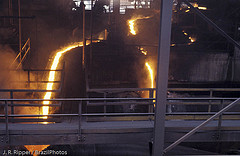Calculation of Phase Diagrams
 This excellent book is probably the first comprehensive guide to the CALPHAD method. CALPHAD is an acronym that was coined in the early 1970s and stands for CALculation of PHAse Diagrams.
This excellent book is probably the first comprehensive guide to the CALPHAD method. CALPHAD is an acronym that was coined in the early 1970s and stands for CALculation of PHAse Diagrams.
The CALPHAD method is based on the fact that a phase diagram is a representation of the thermodynamic properties of a system. Thus, if the thermodynamic properties are known, it is possible to calculate the multi–component phase diagrams. In other words, thermodynamic descriptions of lower–order systems (e.g., the Gibbs energy of each phase) can be combined to extrapolate higher–order systems.
In metallurgical engineering, for example, the CALPHAD method is invaluable when it comes to understanding the relationship between the chemical composition of an alloy (typically based on complex higher–order systems), the processing conditions, the resulting microstructure, and the alloy's final properties. In addition, most alloys undergo one or more phase transformations during use. Such phase transformations can often be understood through the use of phase diagrams (and which now can be calculated, thanks to the CALPHAD method).
The book covers the history of the CALPHAD method; the laws and basic concepts of thermodynamics (enthalpy, heat capacity, chemical equilibrium, Gibbs energy, etc); various experimental techniques to measure thermodynamic quantities and to construct phase diagrams; thermodynamic models for solutions and compound phases (stoichiometric compounds, random substitutional models, sublattice models, ionic liquid models, and aqueous solutions); phase stabilities; short–range and long–range ordering models; the role of magnetic Gibbs energy; computational methods and thermodynamic optimization of phase diagrams; as well as the coupling of thermodynamics and kinetics.
Finally, a number of important practical examples where the CALPHAD method was successfully applied are given and described in detail. The examples include titanium–based Ti–6Al–4V alloy, aluminum casting alloys, corrosion–resistant duplex stainless steels, nickel–based superalloys, high–speed steels, sigma–phase formation, micro–alloyed steels, NiAl–based and TiAl–based intermetallic alloys, magnetic alloys, high–strength cobalt–nickel steels, slag and slag–metal equilibria, chemical vapor deposition processing, hot salt corrosion in gas turbines, and the effect of radiation on the precipitation of silicides in nickel–based alloys.





Адрес заметки: http://metallurgytop.ru/post_1272706939.php
Рейтинг популярности - на эти заметки чаще ссылаются:
- 43 Герой социалистического труда
- 42 Известный телеведущий целую неделю снимал о Южном Урале
- 41 Первый чугун на каменном угле
- 39 Механизация очистки горновых канав
- 38 Замена конвейерных лент
- 36 Отработка верхнего шлака
- 34 Безотходное производство чугуна
- 33 Металлургия России: всем выйти из кризиса Читать полностью:
- 33 Ремонты чугунных и шлаковых канав
- 33 Системы программного управления